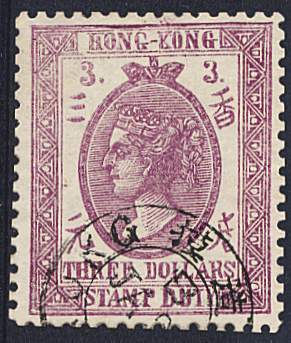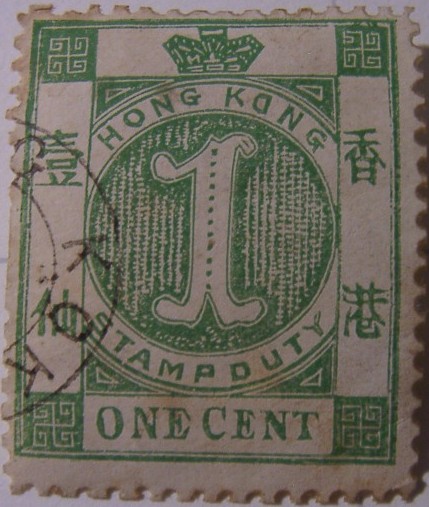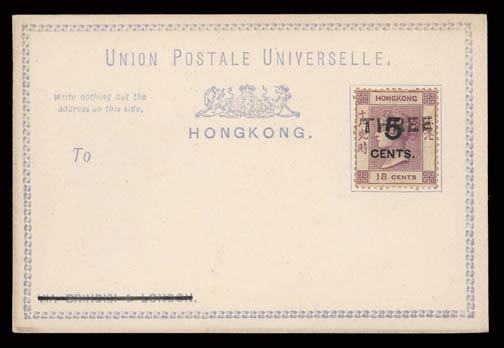 |
|||||
|
|||||
| Preview of Stamps Catalogue: VOLUME 1 |
 |
|||||
|
|||||
| Preview of Stamps Catalogue: VOLUME 1 |
Return To Catalogue - Hong Kong
Note: on my website many of the
pictures can not be seen! They are of course present in the catalogue;
contact me if you want to purchase it.

1 c brown 2 c green 4 c red 6 c orange 10 c blue
For the specialist: these stamps are perforated 14 and have watermark 'Multiple Script CA Crown'.
Value of the stamps |
|||
vc = very common c = common * = not so common ** = uncommon |
*** = very uncommon R = rare RR = very rare RRR = extremely rare |
||
| Value | Unused | Used | Remarks |
| 1 c | c | c | |
| 2 c | c | c | |
| 4 c | * | * | |
| 6 c | * | * | |
| 10 c | * | * | |
Additional values and changed colours in this design were issued in 1938: 6 c red, 8 c brown, 10 c violet, 20 c black and 50 c blue.
Before the introduction of these stamps, the stamps of Hong Kong without any overprint were in use in the following towns: Amoy, Canton, Chefoo, Foochow, Hankow, Shanghai, Tientsin, Swatow and Weihaiwei. The stamps thus used can be recognized by their cancels only. The following numeral cancels were also used in China on these stamps: Amoy: "A1" or "D27", Canton: "C1", Kiung Chow (and Hoihow?): "D28", Hankow: "D29", Foochow: "F1", Shanghai: "S1", Swatow: "S2" and Chefoo? (=Yontai): "Y1". Towncancels were also used. For more examples click here.
1 c brown 2 c green 4 c red 6 c orange 8 c grey 10 c blue 12 c lilac on yellow 20 c green and lilac 25 c violet and lilac 30 c orange and lilac 50 c black on green 1 $ blue and lilac on blue 2 $ brown and red 3 $ lilac and green 5 $ red and green on green 10 $ black and lilac on red
The overprint exists on stamps with watermark 'CA Multiple Crown', later with 'Multiple Script CA Crown' (1921).
Value of the stamps |
|||
vc = very common c = common * = not so common ** = uncommon |
*** = very uncommon R = rare RR = very rare RRR = extremely rare |
||
| Value | Unused | Used | Remarks |
| With watermark 'CA Multiple Crown' | |||
| 1 c | c | c | |
| 2 c | c | c | |
| 4 c | c | vc | |
| 6 c | c | c | |
| 8 c | * | c | |
| 10 c | * | vc | |
| 12 c | * | * | |
| 20 c | * | c | |
| 25 c | ** | * | |
| 30 c | * | * | |
| 50 c | ** | * | |
| 1 $ | *** | * | |
| 2 $ | *** | *** | |
| 3 $ | *** | *** | |
| 5 $ | *** | *** | |
| 10 $ | R | R | |
With Watermark 'CA Script Multiple Crown' |
|||
| 1 c | vc | c | |
| 2 c | c | c | |
| 4 c | c | c | |
| 6 c | c | c | |
| 8 c | c | c | |
| 10 c | c | c | |
| 20 c | * | * | |
| 25 c | * | * | |
| 50 c | * | * | |
| 1 $ | ** | ** | |
| 2 $ | *** | *** | |
Postcards with the same overprint, example:

(reduced sized image)
The following values with the image of King George V exist 1 c brown (1916), 1 1/2 c orange (1918), 4 c red (1916), '1 1/2 c.' on 1 c brown (1918) and 6 c on 4 c red (1918).
A newspaper wrapper in the value 2 c green and overprinted "CHINA" with King George V was issued in 1916.
3 c orange 3 c lilac (1885) 20 c lilac (1885) 25 c green 25 c lilac (1885) 30 c brown 30 c lilac (1885) 50 c lilac (shades) 1 $ blue 1 $ lilac (1885) 1.50 $ brown 1.50 $ green (1885) 2 $ green (shades) 3 $ violet (shades) 10 $ red 10 $ green (1885) Surcharged
'12 CENTS' on $10 red (1881) 5 $ on 10 $ lilac on red (1892) 1 $ on 2 $ green (with vertical and diagonal chinese overprint) 1 $ on 2 $ green (with vertical chinese overprint only) 1 $ on 2 $ green (with no chinese overprint)
The values 2 $ green, 3 $ lilac and 10 $ red were allowed for postal usage. The surcharged stamps 5 $ on 10 $ lilac on red and 1 $ on 2 $ green (with or without chinese overprint) could also be used for this purpose. Other values can be found with postal cancels, but are either forgeries or unauthorised usage of fiscal stamps.

(Postally used? fiscal stamp of $3, reduced size)
P.S. The cancel "HONG KONG PAID ALL" is a fiscal cancel and not a postal one:

(Fiscal cancel "HONG KONG PAID ALL")
This cancel in red was used on envelopes only (not on stamps) on mail from the USA from 1868 to 1877.
Forgeries seem to exist (to cheat the authorities, they have perforation 10 1/2 instead of 15 1/2 x 15 or 14). Could the next forgeries be such forgeries?:



Forged fiscal stamps: a 3 $ and a 1.50 $ fiscal stamp forgery
(note the strange face of the Queen in the 3 $ forgery). I've
also seen a 2 $ green fiscal stamp, with the lettering very badly
done. They all seem to have the cancel "HONG KONG B JA
20"+Chinese characters, indicating that they were probably
made to deceive collectors and not the authorities.
2 c grey to lilac
Postage stamps with overprint "S.O." + chinese characters (Stamp Office: 2 c red or 10 c lilac on red) or "S.D." + chinese characters (Stamp Duty; 2 c red) are fiscal stamps issued in 1891. They are rare and forged overprints exist. Examples:

Probably genuine overprints



(5 c green, smaller size, 1908)
1 c lilac 5 c lilac 5 c green (smaller size, 1908) 10 c lilac 10 c lilac (smaller size, 1917) 15 c green (smaller size, 1917) Provisional overprint "RECEIPT 15 Cts. STAMP" on 10 c lilac


Bogus 1 c green stamp and a forgery of the 5 c lilac stamp.

In this design the following values exist: 1 c green and lilac, 2 c brown and black, 3 c lilac and green, 5 c blue and black, 10 c brown and grey, 15 c green and lilac, 20 c brown and lilac, 25 c green (two shades), 30 c blue and lilac, 40c green and orange, 50 c yellow and green, 75 c brown and green, 1 $ red and black, 1.50 $ green (two shades), 2 $ lilac and black, 3 $ green, $ 4 blue and black, 5 $ brown and lilac, 6 $ blue and green, 10 $ red and lilac, 20 $ black and lilac, 25 $ lilac and black, 40 $ orange and green, 50 $ brown and black on yellow, 100 $ red and black on red and 200 $ blue and black on blue. Some provisional overprints 'FIVE' on 10 c and 'FIVE CENTS' on 10 c seem to exist (I have never seen them).
Many of these stamps exist with overprint "B OF E" (Bill of Exchange), they were issued in 1907.
A postage stamp with King Edward VIII in the value 12 c also exist with overprint "10 Cents Stamp Duty":

Fiscal stamp; 12 c overprinted "10 Cents Stamp Duty"
and Chinese characters, issued in 1933.
In this design the following values exist: 2 c brown and black, 3 c lilac and green, 5 c blue and black, 10 c green and grey, 15 c green and lilac, 20 c brown and lilac, 25 c green (two shades), 30 c blue and lilac, 40 c green and orange, 50 c yellow and green, 75 c brown and green, 1 $ red and black, 1.50 $ green (two shades), 2 $ lilac and black, 3 $ green, $ 4 blue and black, 5 $ brown and lilac, 6 $ blue and green, 10 $ red and lilac, 20 $ black and lilac, 25 $ lilac and black, 40 $ orange and green, 50 $ orange and black on yellow, 100 $ lilac on red and 200 $ blue and black on blue.
Many of these stamps exist with overprint "B OF E" (Bill of Exchange), they were issued in 1912, example:

Example:

Three special 'Postcard Stamps' were issued in 1879; '3 CENTS.' on 16 c yellow, 'THREE' on '5 CENTS.' on 18 c lilac and '5 CENTS.' on 18 c lilac. Example:

('THREE CENTS' on '5 CENTS.' on 18 c pasted on a postcard)
The first postcards were issued in 1880, they have the same design as the postage stamps (Queen Victoria). The following values exist: 1 c green (1880) 3 c brown (1880), 4 c grey (1896), 'ONE CENT' on 3 c brown (1881), 'ONE CENT' on 4 c grey (1881).
Some Reply Cards were issued in 1892 in the values: 1 c green, 3 c brown, 4 c red (1902), 4 c on 3 c brown (surcharge in red: 1895 and surcharge in black: 1900).
Envelopes with Queen Victoria exist in the values: 1 c yellow, 2 c green, 4 c red, 5 c lilac and 10 c blue.
A wrapper for newspapers was issued in 1900 with the image of Queen Victoria in the value 2 c green.
Postcards with the design of King Edward VII exist in the values 1 c green, 1 c brown (1909) and 4 c red. They were issued from 1903 onwards.
Envelopes with King Edward VII are known in the values: 1 c brown, 2 c green, 4 c red, 5 c lilac and 10 c blue (issued in 1902).
Newspaper wrappers with King Edward VII exist in the values 2 c green and 4 c red (both issued in 1903).
Postcards with the design of King George V exist in the values 1 c brown, 1 1/2 c orange (1918), 2 c green, 2 c grey and 4 c red (issued from 1912 onwards).
Envelopes with King George V were issued in 1912 in the values 4 c red.
A newspaper wrapper in the value 2 c green with King George V was issued in 1912.

Image obtained from http://www.poseal.com/hongkong01.html
(-) brown and blue wavy background
This label has perforation 12.
Value of the stamps |
|||
vc = very common c = common * = not so common ** = uncommon |
*** = very uncommon R = rare RR = very rare RRR = extremely rare |
||
| Value | Unused | Used | Remarks |
| (-) | RR | RR | |


Images obtained from http://www.poseal.com/hongkong01.html
(-) blue (with ornamental border) (-) brown (with ornamental border) (-) blue (with dotted border, 1925)
Specialists distinguish two types of the blue stamps with ornamental border: among the differences, with or without dot behind the word 'SEALED'. Check the above mentioned website for more details.
Value of the stamps |
|||
vc = very common c = common * = not so common ** = uncommon |
*** = very uncommon R = rare RR = very rare RRR = extremely rare |
||
| Value | Unused | Used | Remarks |
| (-) blue | RR | RR | With ornamental border |
| (-) brown | R | R | |
| (-) blue | *** | *** | With dotted border |
In 1936 still another type was issued, with straight inscriptions.